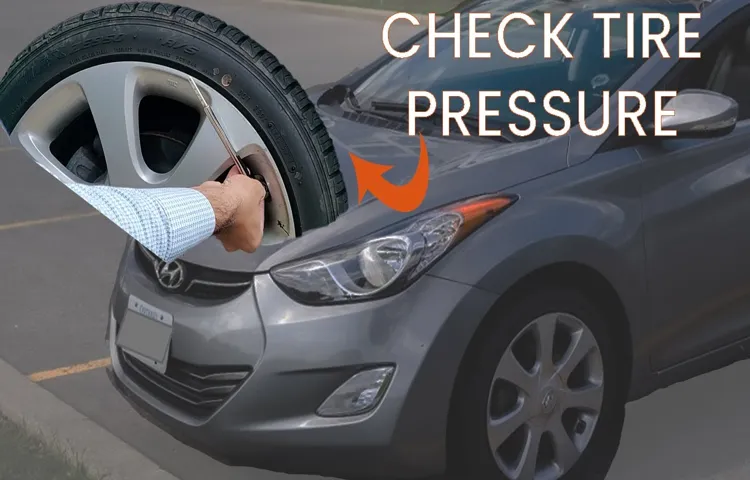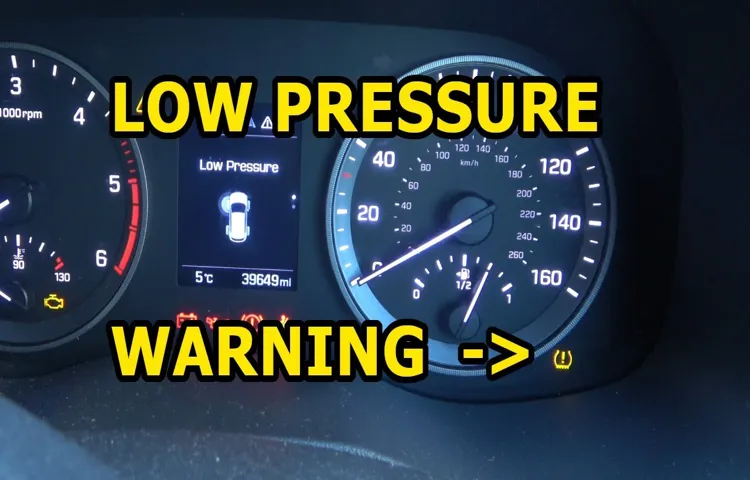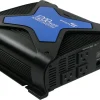Maintaining the health and safety of your vehicle is crucial, and it all starts with something as simple as checking your tire pressure. Whether you’re a new Hyundai Elantra owner or simply need a refresher on the process, we’ve got you covered. Checking the tire pressure on your Hyundai Elantra is a quick and easy task that can be accomplished in just a few minutes.
By keeping your tires properly inflated, you’ll not only prolong the life of your tires, but you’ll also improve your vehicle’s fuel efficiency and handling. In this guide, we’ll walk you through the step-by-step process of checking the tire pressure on your Hyundai Elantra. We’ll also cover the importance of maintaining proper tire pressure, how often you should check your tires, and what to do if your tire pressure is too high or too low.
So, grab your tire pressure gauge and let’s get started!
Table of Contents
Why Checking Tire Pressure is Important
To keep your Hyundai Elantra running smoothly, it’s important to check your tire pressure regularly. Fortunately, checking your tire pressure is a fairly easy task that you can do yourself with just a few simple tools. First, make sure you have a reliable tire pressure gauge.
You can find this at most auto parts stores or online. Then, locate the tire pressure specifications for your Hyundai Elantra, which are often found in your owner’s manual or on the inside of the driver’s side door. Once you have your gauge and specifications, check your tire pressure when the tires are cold.
Simply remove the valve cap, attach the gauge to the valve stem, and read the pressure. If the pressure is too low, use an air compressor to fill it to the proper level. By checking your tire pressure regularly, you’ll not only extend the life of your tires, but you’ll also increase your car’s fuel efficiency and ensure a safer driving experience.
So don’t forget to make checking your tire pressure a regular part of your car maintenance routine!
Safety
Tire Pressure Have you ever wondered why checking your tire pressure is important? Well, keeping the right tire pressure is crucial for your vehicle’s safety. A tire that is underinflated can cause excessive wear on the tire’s outer edges, reducing its lifespan. Moreover, an underinflated tire creates more surface area, increasing the tire’s rolling resistance, which leads to poor fuel efficiency, costing you more money at the pump.
On the other hand, an overinflated tire reduces the tire’s grip on the road, thereby compromising your car’s handling and performance. Additionally, a tire with too much air pressure can lead to a tire blowout, which can be dangerous at high speeds. Therefore, it is important to check your tire pressure regularly and keep it maintained at the recommended PSI for optimal performance and safety.
So, take a few minutes to check your tire pressure before your next road trip, and you’ll save money and keep your vehicle safe on the road!

Fuel Efficiency
Fuel efficiency Did you know that checking your tire pressure regularly can significantly improve your vehicle’s fuel efficiency? It’s true! Properly inflated tires can reduce rolling resistance on the road, which means your engine won’t have to work as hard to power your car forward. When your tires are underinflated, more surface area comes into contact with the road, increasing the force required to move your vehicle. This not only wastes fuel, but it also puts unnecessary strain on your engine, causing it to wear out faster.
By keeping your tires inflated to the manufacturer’s recommended pressure, you can boost your fuel economy and save money at the gas pump. So, make sure you check your tire pressure regularly and keep them properly inflated for better fuel efficiency!
Tire Longevity
Keeping your tires properly inflated is crucial to ensure their longevity. Not only can low tire pressure decrease fuel efficiency, but it can also cause excessive wear and tear on the tire itself. When a tire is underinflated, more of the surface area comes into contact with the road, causing it to heat up and wear down faster.
Additionally, an underinflated tire can affect the handling and performance of your vehicle, making it less safe to drive. By taking a few minutes to regularly check your tire pressure and ensure it is at the recommended level, you can not only save money on gas but also maximize the lifespan of your tires. Don’t let a simple task like checking tire pressure cost you more in the long run by causing premature tire wear and additional maintenance costs.
When to Check Tire Pressure
If you own a Hyundai Elantra, knowing how to check tire pressure is crucial to maintaining optimal performance and safety on the road. It’s recommended to check tire pressure at least once a month or before any long road trips. However, it’s also important to check tire pressure when the temperature changes drastically, as temperature fluctuations can cause the tire pressure to fluctuate as well.
Use a tire pressure gauge to measure the pressure when the tires are cold (haven’t been driven for at least an hour) and compare it to the recommended pressure listed in your vehicle’s manual or on the sticker located inside the driver’s side door jamb. If the pressure is too low, add air to the tires until they reach the recommended pressure. Overinflating the tires can also be dangerous, so be sure not to exceed the recommended pressure.
By regularly checking your Hyundai Elantra’s tire pressure, you can help improve fuel efficiency and reduce wear and tear on your tires, ultimately saving you money in the long run.
Before a Long Trip
Before embarking on a long trip, it’s essential to check your tire pressure. Properly inflated tires not only ensure a smoother ride but also improve your car’s fuel efficiency and reduce the risk of a blowout. But when is the best time to check your tire pressure? Ideally, it’s best to check your tire pressure when your car’s tires are cold, which means you haven’t driven for more than an hour or have driven less than a mile.
Checking the pressure when the tires are hot can give you inaccurate readings. It’s also important to check your spare tire’s pressure and make sure it’s in good condition in case of an emergency. So, before your next long trip, take a few minutes to check your tire pressure, and you’ll have a safer, more comfortable, and more efficient journey.
Once a Month
Tire pressure is crucial for the safety and performance of your vehicle. That’s why it’s important to check your tire pressure regularly. Many experts recommend checking your tire pressure once a month to ensure it’s at the optimal level.
Doing so will help improve your vehicle’s fuel efficiency, prevent wear and tear on the tires, and enhance your overall driving experience. You can easily check your tire pressure with a tire pressure gauge, available at most auto parts stores. Make sure to check the pressure when the tires are cold for the most accurate reading.
Keeping your tires properly inflated will not only save you money in the long run but also keep you and your passengers safe on the road.
When the Tires are Cold
Checking tire pressure regularly is essential for maintaining good fuel economy, safe and comfortable handling, and extending the life of your tires. One of the most important considerations when checking your tire pressure is to do so when the tires are cold, that is, before they’ve been driven much or at all that day. Driving heats up the tires and can cause the pressure to be higher than it would otherwise be, which can lead to inaccurate readings.
Ideally, you should check your tire pressure once a month and always when the tires are cold. You can find the recommended pressure for your tires in your vehicle owner’s manual or on a label inside the driver’s side door. And don’t forget to check your spare tire as well to ensure you’re prepared in case of a flat on the road.
By regularly checking your tire pressure, you’ll enjoy better performance overall, safer driving, and longer-lasting tires.
Steps to Check Tire Pressure on Hyundai Elantra
Checking tire pressure on your Hyundai Elantra is an essential aspect of keeping your vehicle safe, running smoothly, and improving fuel efficiency. To check your tire pressure, the first step is to find the recommended tire pressure for your particular Elantra model, which can be found in your car manual or on a sticker located on the driver’s side door jamb. To accurately measure your tire pressure, you will need a tire pressure gauge, which can be purchased at most auto parts stores.
Simply unscrew the valve cap on each tire, place the gauge on the valve stem, and read the pressure measurement on the gauge. If your tire pressure is below the recommended level, use an air compressor to add air until it reaches the correct pressure. It’s important to note that tire pressure can decrease as temperatures change, so it’s recommended to check your tire pressure at least once a month and before any long road trips.
By regularly checking your tire pressure, you can help prevent accidents and increase the lifespan of your Hyundai Elantra’s tires.
Step 1: Locate the Tire Pressure Information
If you want to check the tire pressure on a Hyundai Elantra, the first step is to locate the tire pressure information. This can usually be found on a sticker in one of two places: either on the driver’s side door jam or inside the fuel door. It’s important to have the correct tire pressure because it affects the handling, fuel efficiency, and overall safety of the vehicle.
Once you’ve found the sticker, take note of the recommended tire pressure for your specific make and model, as well as whether it applies to the front or rear tires (sometimes they have different pressures). From there, you can use a tire pressure gauge to check your current tire pressure and adjust as necessary. Keeping your tires properly inflated can help prolong their lifespan and save you money on fuel costs in the long run.
Step 2: Remove Valve Stem Caps
To begin checking the tire pressure on your Hyundai Elantra, the first step is to locate the valve stem on each tire. The valve stem is usually found at the center of each wheel and can be identified by a small plastic or metal cap covering it. Once you’ve located all the valve stems, the next step is to remove the valve stem caps.
Use caution when doing so, as these caps can be tight and may require a bit of force to remove. With the caps removed, you are now ready to check the tire pressure of each tire using a tire pressure gauge. Remember to check the recommended tire pressure for your Hyundai Elantra, which can be found in the owner’s manual or on a sticker located on the driver’s side doorjamb.
By regularly checking the tire pressure on your Hyundai Elantra, you can ensure that your tires are properly inflated, which can improve fuel efficiency and prolong the life of your tires.
Step 3: Use a Tire Pressure Gauge
When it comes to maintaining your Hyundai Elantra, checking the tire pressure is an essential step. Not only does it ensure your safety while driving, but it can also improve your car’s fuel efficiency and prolong the life of your tires. To get an accurate reading, you’ll want to use a tire pressure gauge.
These tools are simple to operate and can be found at any auto parts store. To use them, remove the valve cap from your tire and firmly press the gauge onto the valve stem. Read the pressure on the gauge and compare it to your car’s recommended pressure, which is typically found in the owner’s manual or on the door jamb.
If the pressure is too low or high, use an air compressor to add or remove air until the pressure is just right. Checking your tire pressure regularly is a small step that can make a big difference in the safety and performance of your Hyundai Elantra.
Step 4: Compare Pressure with Recommended Range
When it comes to checking tire pressure on your Hyundai Elantra, there are some simple steps to follow. Step 4 involves comparing the pressure with the recommended range, which is crucial for ensuring optimal performance and safety. To do this, you’ll need to consult the owner’s manual or look for a label on the driver’s side door jamb that shows the recommended tire pressure for your specific vehicle.
Then, using a tire pressure gauge, check the pressure in each tire and compare it to the recommended range. It’s important to remember that underinflated tires can decrease fuel efficiency and increase the risk of blowouts, while overinflated tires can lead to poor handling and uneven wear. By taking the time to check your tire pressure regularly and ensuring it falls within the recommended range, you can help keep yourself and your passengers safe on the road.
Step 5: Inflate or Deflate Tires as Necessary
Checking tire pressure regularly is an important task for any car owner, and it’s no different for your Hyundai Elantra. In step five of the process, it’s time to inflate or deflate your tires as needed. The best way to determine the correct tire pressure for your Hyundai Elantra is to check the owner’s manual or the driver’s side door jamb.
Once you have this information, it’s time to grab your tire pressure gauge and accurately measure the pressure in each tire. If any of your tires are overinflated, releasing some air with the gauge will fix the issue. If the tire pressure is too low, simply add air until it reaches the recommended level.
This step is crucial for maintaining optimal handling, fuel efficiency, and overall performance of your Hyundai Elantra. Plus, it ensures your safety on the road by reducing the risk of a tire blowout or losing traction. So, don’t forget to check your tire pressure regularly, especially before any long trips.
Conclusion
Checking the tire pressure on your Hyundai Elantra is as easy as pie – or should we say, as easy as a walk in the park. With just a few simple steps, you can ensure that your car is running smoothly and efficiently, while maintaining your safety on the road. Remember, keeping your tires properly inflated not only saves you money on fuel but also helps extend the life of your tires.
So, next time you’re out and about, take a minute to check your tire pressure and impress your friends with your newfound automotive savvy. Just don’t forget to bring a tire pressure gauge – you don’t want to be blowing hot air!”
FAQs
What is the recommended tire pressure for a Hyundai Elantra?
The recommended tire pressure for a Hyundai Elantra is 32 PSI.
How often should I check the tire pressure on my Hyundai Elantra?
It is recommended to check the tire pressure on your Hyundai Elantra at least once a month.
Can I check my Hyundai Elantra’s tire pressure myself?
Yes, you can check your Hyundai Elantra’s tire pressure yourself using a tire pressure gauge and following the recommended PSI in the owner’s manual.
Why is it important to maintain proper tire pressure on a Hyundai Elantra?
Maintaining proper tire pressure on a Hyundai Elantra can improve fuel efficiency, prolong tire life, and ensure proper vehicle handling and safety.
What should I do if the tire pressure on my Hyundai Elantra is too low?
If the tire pressure on your Hyundai Elantra is too low, you should add air to the tires until they reach the recommended PSI.
What should I do if the tire pressure on my Hyundai Elantra is too high?
If the tire pressure on your Hyundai Elantra is too high, you should release some air from the tires until they reach the recommended PSI.
Can extreme temperatures affect the tire pressure on my Hyundai Elantra?
Yes, extreme temperatures can cause changes in tire pressure on your Hyundai Elantra, which is why it is important to check the pressure regularly and adjust as needed.



